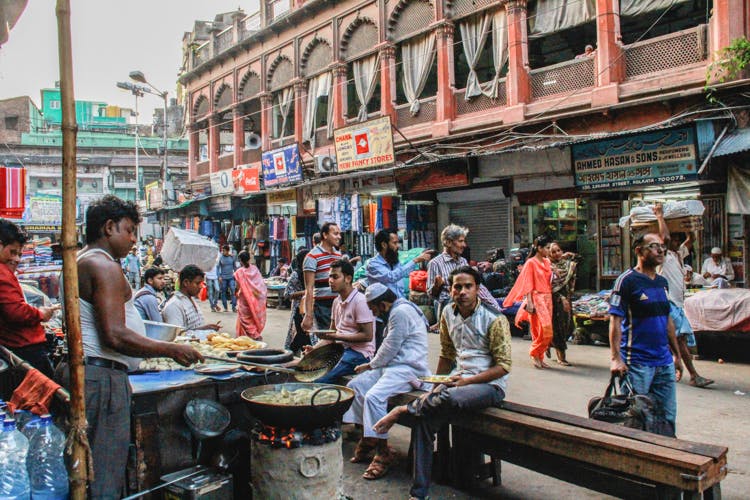In its glory days, it used to sell everything, even cow’s tails from Tibet! Even today, India’s largest wholesale market continues to be a pit stop for many. Here’s a guide to Burrabazaar.
Hood Guide: Where To Shop, What To Eat & See In Burrabazaar
Shortcut
What Is It?
The largest wholesale market in India, Burrabazar used to be a yarn and textile market under the British era. Merchants of yarn and cloth market flourished here – people like Shobharam Bysack became a millionaire by supplying textiles to British East India Company. Over the years, this market has survived many fires – both recent and old {Siraj-ud-Daulah had set fire to the market in 1756}. In its heydays, it was said you could find everything under the sun here – English broadcloth and cashmere silk to ivory from Ceylon and cow’s tails from Tibet!
In Bengali, it is called ‘Barobazar’, it was named after Shiva – ‘buro’ being the popular name for him. Hindi-speaking merchants who ousted the earlier local merchants, made it ‘Bara’.
Super Speciality Katras
All of Burrabazar is divided into specific areas or specilaised sub-markets named after the commodity it deals in – Dhotipatti, Fancypatti, Tulapatti, Chinipatti etc. These are further divided into katras. Each katra is known for a particular item. For instance, Raja Katra shops deal in spices, Manohar Das Katra is mostly about hardware and textile, the Vikram Chand Market and Khangrapatti sell electronic goods and artificial ornaments, and so on.
Paper Marts. Spices, Tamchini Plates And Other Crockery
People looking for stationery items in bulk {and cheap}, head to this market. There is a huge area here with shops selling paper of different kinds. Getting married, head to the area with wedding cards. Then there are tons of hardware stores selling raw materials needed for construction, chocolates and sweets, toys, stainless steel tiffon boxes, cosmetics, spices of all kinds, and much more.
Many top companies and industries source their materials from Burrabazar. You will also the streets are loaded with stalls selling Chinese lanterns, fruits, souvenirs, and other sparkling things.
We love the shops selling tamchini plates {enamel plates with handpainted or spraypainted stencil designs}. Only a few remain, so if you want to stock up, we suggest you visit soon.
Sarees, Lehengas At Dirt Cheap Prices
Bestie’s wedding coming up? Head here for everything from wedding cards to lehengas, sarees and fabrics. Bastalla Street and Kalakar Street have a range of sarees and dress material shops stocking bright colours and eembroidered fabrics and borders.
What To Eat
With so many shopkeepers and traders in teh area, it is no wonder that this place is a street food paradise.-It has stalls selling virtually every genre of food – dahi kachori, bhelpuri, jhalmuri, ragda patties, matka kulfi, samosas, chaat, jalebi, pavbhaji, chole kulche, etc. One thing you just have to try are the chillas – pancakes made of green mung dal spiced with ginger, chili and hing. For a cup of steaming hot chai and great samosas, head to the famous Tiwari Brother and finish off with the kesariya kulfi. Another famous tea place is Bapu tea stall.
Before you head back home, buy a pack of the gaathiyas at Lakhuram Bhujiyawala {opposite Bapu tea stall}. They specialise in this Rajasthani snack – fried strips made from besan {chickpea flour} with a dash of ajwain {carom seeds}, tumeric, cumin and chilli.
The area also has some well-known sweet shops {including the usual Haldirams’}.
What To See
There’s so much here, you won’t be able to figure out what to check out first. The area is adjacent to Howrah Bridge and the majestic old warehouses of Strand Road. From time to time, you will catch a glimpse of the towering bridge and the Hoogly river. “Within this rough boundary it is a world in itself” – said Subhajoy Roy in his article, “We didn’t start the fire” in The Telegraph {2008-02-08.}
Since this was close to the port, it was a multicultural melting pot of many trading communities when the Brits were here. You will find an Armenian Street here, and the Armenian Church of the Holy Nazareth {built in 1724} on an old Armenian burial ground. It was built by Levon Ghevond, an Armenian architect from Iran. Look out for the mural tablets in the overhead gallery and the three oil paintings, including one of the Last Supper.
Also check out the largest mosque in Kolkata – Nakhoda Masjid, on the Zakariya Street and Rabindra Sarani crossing near Burrabazar – was built in 1926. The main funder of the structure was a shipping prince and hence it was named Nakhoda, or ‘mariner’. This is the largest masjid in Kolkata. Its architecture is inspired by Akbar’s tomb in Sikandra. Its gateway was built as a replica of the Buland Darwaza in Fatehpur Sikri. Several granite stones were brought in for its construction from Tolepur. Inside you’ll find red rock paving the way to a small fountain where people wash their hands after praying.

